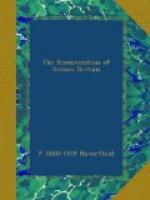[Footnote 4: Ravennas (ed. Parthey and Pinder), pp. 425 foll. I have given a list of the towns in my Appendix to Mommsen’s Provinces of the Empire (English trans., 1909), ii. 352.]
Of the smaller local organizations, little can be said. Towns existed, but many of them were the tribal capitals mentioned in the last paragraph, and these, as I have said, were doubtless ruled by the magistrates of the tribes. It is idle to guess who administered the towns that were not such capitals or who controlled the various villages scattered through the country. Nor can we pretend to know much more about the size and character of the estates which corresponded to the country-houses and farms of which remains survive. The ‘villa’ system of demesne farms and serfs or coloni[1] which obtained elsewhere was doubtless familiar in Britain; indeed, the Theodosian Code definitely refers to British coloni.[2] But whether it was the only rural system in Britain is beyond proof, and previous attempts to work out the problem have done little more than demonstrate the fact.[3] It is quite possible that here, or indeed in any province, other forms of estates and of land tenure may have existed beside the predominant villa.[4] The one thing needed is evidence. And in any case the net result appears fairly certain. The bulk of British local government must have been carried on through Roman municipalities, through imperial estates, and still more through tribal civitates using a Romanized constitution. The bulk of the landed estates must have conformed in their legal aspects to the ‘villas’ of other provinces. Whatever room there may be for survival of native customs or institutions, we have no evidence that they survived, within the Romanized area, either in great amount or in any form which contrasted with the general Roman character of the country.
[Footnote 1: The term ‘villa’ is generally used to denote Romano-British country-houses and farms, irrespective of their legal classification. The use is so firmly established, both in England and abroad, that it would be idle to attempt to alter it. But for clearness I have thought it better in this paper to employ the term ‘villa’ only where I refer to the definite ‘villa’ system.]
[Footnote 2: Cod. Theod. xi. 7.2.]
[Footnote 3: For instance, Mr. Seebohm (English Village Community, pp. 254 foll.) connects the suffix ‘ham’ with the Roman ‘villa’ and apparently argues that the occurrence of the suffix indicates in general the former existence of a ‘villa’. But his map showing the percentage of local names ending in ‘ham’ in various counties disproves his view completely. For the distribution of the suffix ‘ham’ and the frequency of Roman country-houses and farms do not coincide. In Norfolk, for instance, ‘ham’ is common, but there is hardly a trace of a Roman country-house or farm in the whole county (Victoria Hist. of Norfolk, i. 294-8). Somerset, on the other hand, is crowded with Roman country-houses, and has hardly any ’hams’.]




